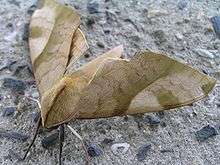Clanis bilineata
Clanis bilineata, the two-lined velvet hawkmoth, is a moth of the family Sphingidae first described by Francis Walker in 1866.
| Clanis bilineata | |
|---|---|
 | |
| Clanis bilineata tsingtauica | |
| Scientific classification | |
| Kingdom: | Animalia |
| Phylum: | Arthropoda |
| Class: | Insecta |
| Order: | Lepidoptera |
| Family: | Sphingidae |
| Genus: | Clanis |
| Species: | C. bilineata |
| Binomial name | |
| Clanis bilineata | |
| Synonyms | |
| |
Distribution
It is found in Asia, but see the subspecies section for a detailed range.
Description
The wingspan is 94–150 mm for subspecies C. b. bilineata and 94–120 mm for subspecies C. b. tsingtauica.
 Male C. b. bilineata
Male C. b. bilineata Male C. b. bilineata, underside
Male C. b. bilineata, underside Female C. b. bilineata
Female C. b. bilineata Female C. b. bilineata, underside
Female C. b. bilineata, underside
Biology
Adults of the nominate subspecies are on wing from late February until October, with peaks in April, late July-early August, and mid-September in Hong Kong. There are multiple generations per year. Subspecies C. b. tsingtauica is on wing from May to late September in Korea.
Larvae of the nominate subspecies have been recorded on Pongamia pinnata, Millettia atropurpurea and Pterocarpus marsupium in India. In southern China it has been recorded from Mucuna and Pueraria. Subspecies C. b. tsingtauica is monophagous on Fabaceae in China, including Acacia, Glycine, Mucuna, Pueraria and Robinia species. Other recorded food plants include Olea and Paulownia but these are almost certainly erroneous.
Subspecies C. b. tsingtauica is a major pest of soya beans in China, often defoliating entire fields.
Subspecies
Some authors recognise three distinct subspecies, while others regard them as synonyms:
- Clanis bilineata bilineata (southern India, then from Nepal and northern India (Sikkim) across southern China to Taiwan)
- Clanis bilineata formosana (Taiwan)
- Clanis bilineata tsingtauica (the Russian Far East, Japan, Korea and north-eastern China, as far south as Shaanxi and Zhejiang)
 Male C. b. formosana
Male C. b. formosana Male C. b. formosana, underside
Male C. b. formosana, underside Female C. b. formosana
Female C. b. formosana Female C. b. formosana, underside
Female C. b. formosana, underside
References
- "CATE Creating a Taxonomic eScience - Sphingidae". Cate-sphingidae.org. Archived from the original on 2012-12-20. Retrieved 2011-11-01.
External links
- Pittaway, A. R.; Kitching, I. J. (2018). "Clanis bilineata bilineata (Walker, 1866) -- Two-lined velvet hawkmoth". Sphingidae of the Eastern Palaearctic. Retrieved December 18, 2018.
- Pittaway, A. R.; Kitching, I. J. (2018). "Clanis bilineata formosana Gehlen, 1941 -- Two-lined velvet hawkmoth". Sphingidae of the Eastern Palaearctic. Retrieved December 18, 2018.
- Pittaway, A. R.; Kitching, I. J. (2018). "Clanis bilineata tsingtauica Mell, 1922 -- Two-lined velvet hawkmoth". Sphingidae of the Eastern Palaearctic. Retrieved December 18, 2018.